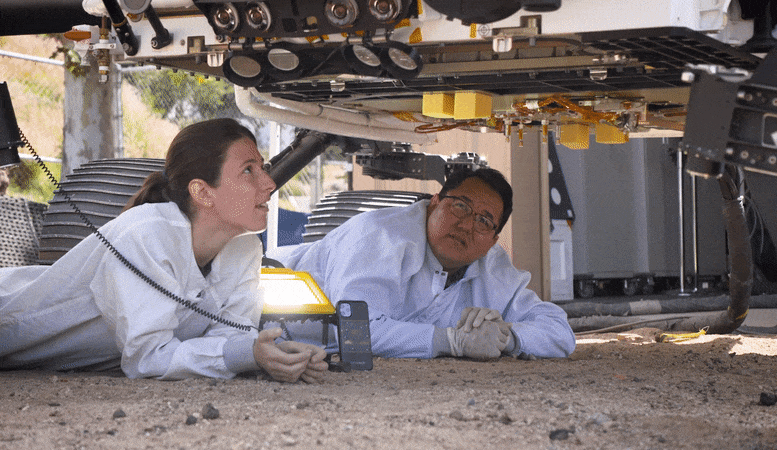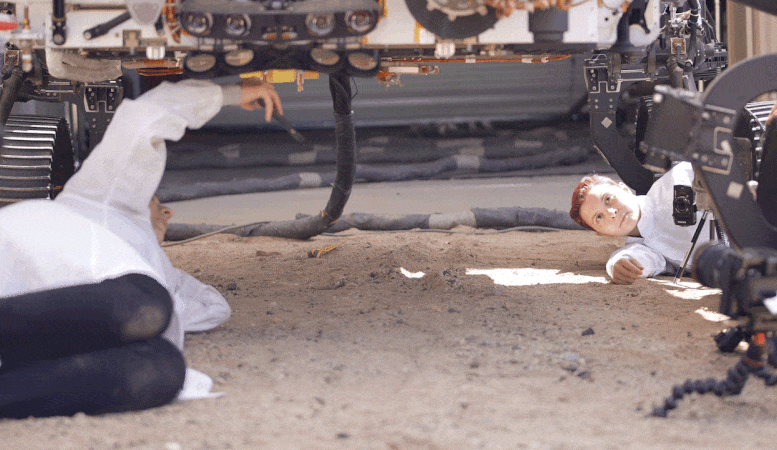
Der NASA-Rover Perseverance deponierte am 21. Dezember 2022, dem Marstag 653, oder dem Sol der Mission, die erste von mehreren Proben auf dem Mars. Bildnachweis: NASA/JPL-Caltech/MSSS
Das mit Gestein gefüllte Probenröhrchen wird eines von 10 Röhrchen sein, die ein Röhrchenlager bilden[{“ attribute=““>Mars Sample Return campaign could consider for a trip to Earth for in-depth analysis.
On December 22, NASA’s Perseverance Mars rover placed a titanium tube containing a rock sample on the Red Planet’s surface. Over the next two months, the rover will build humanity’s first sample depot on another planet by depositing a total of 10 tubes at the location, called “Three Forks.” The establishment of the depot marks a historic early step in the Mars Sample Return campaign.

Perseverance Deposits Its First Sample on the Martian Surface: Once the Perseverance team confirmed the first sample tube was on the surface, they positioned the WATSON camera located at the end of the rover’s robotic arm to peer beneath the rover, checking to be sure that the tube hadn’t rolled into the path of the wheels. Credits: NASA/JPL-Caltech/MSSS
Perseverance has been taking duplicate samples from rock targets the mission selects. The rover currently has the other 17 samples (including one atmospheric sample) taken so far in its belly. Based on the architecture of the Mars Sample Return campaign, the rover would deliver samples to a future robotic lander. The lander would, in turn, use a robotic arm to place the samples in a containment capsule aboard a small rocket that would blast off to Mars orbit, where another spacecraft would capture the sample container and return it safely to Earth.
The depot will serve as a backup if Perseverance can’t deliver its samples. In that case, a pair of Sample Recovery Helicopters would be called upon to finish the job.

Testing a Sample Drop in the Mars Yard: Engineers use OPTIMISM, a full-size replica of NASA’s Perseverance rover, to test how it will deposit its first sample tube on the Martian surface. Credits: NASA/JPL-Caltech
The first sample to drop was a chalk-size core of igneous rock informally named “Malay,” which was collected on January 31, 2022, in a region of Mars’ Jezero Crater called “South Séítah.” Perseverance’s complex Sampling and Caching System took almost an hour to retrieve the metal tube from inside the rover’s belly, view it one last time with its internal CacheCam, and drop the sample roughly 3 feet (89 centimeters) onto a carefully selected patch of Martian surface.
But the job wasn’t done for engineers at NASA’s Jet Propulsion Laboratory in Southern California, which built Perseverance and leads the mission. Once they confirmed the tube had dropped, the team positioned the WATSON camera located at the end of Perseverance’s 7-foot-long (2-meter-long) robotic arm to peer beneath the rover, checking to be sure that the tube hadn’t rolled into the path of the rover’s wheels.

OPTIMISM Sticks the Landing: Engineers react with surprise while testing how NASA’s Perseverance rover will deposit its sample tubes on the Martian surface. Credit: NASA/JPL-Caltech
They also wanted to ensure the tube hadn’t landed in such a way that it was standing on its end (each tube has a flat end piece called a “glove” to make it easier to be picked up by future missions). That occurred less than 5% of the time during testing with Perseverance’s Earthly twin in JPL’s Mars Yard. In case it does happen on Mars, the mission has written a series of commands for Perseverance to carefully knock the tube over with part of the turret at the end of its robotic arm.
In the coming weeks, they’ll have other opportunities to see whether Perseverance needs to use the technique as the rover deposits more samples at the Three Forks cache.
“Seeing our first sample on the ground is a great capstone to our prime mission period, which ends on Jan. 6,” said Rick Welch, Perseverance’s deputy project manager at JPL. “It’s a nice alignment that, just as we’re starting our cache, we’re also closing this first chapter of the mission.”
Rückführung von Marsgesteinsproben zur Erde: Diese kurze Animation zeigt Schlüsselmomente der Mars-Sample-Return-Kampagne der NASA und der European Space Agency, von der Landung auf dem Mars und der Sicherung der Probenröhrchen bis hin zu ihrer Freigabe von der Oberfläche und ihrem Transport zurück zur Erde. Quelle: NASA/ESA/JPL-Caltech/GSFC/MSFC
Mehr zum Auftrag
Das Hauptziel der Mission Mars Perseverance ist Astrobiologie, einschließlich der Suche nach Zeichen des alten mikrobiellen Lebens. Der Rover wird die Geologie und das vergangene Klima des Planeten charakterisieren, den Weg für die menschliche Erforschung des Roten Planeten ebnen und die erste Mission sein, die Marsgestein und Regolithe (zerbrochene Felsen und Staub) sammelt und zwischenlagert.
Nachfolgende NASA-Missionen werden in Zusammenarbeit mit der Europäischen Weltraumorganisation (ESA) Raumfahrzeuge zum Mars schicken, um diese versiegelten Proben von der Oberfläche zu sammeln und sie zur eingehenden Analyse zur Erde zurückzubringen.
Die Mars 2020 Perseverance-Mission ist Teil des Monderkundungsansatzes der NASA für den Mars, der Folgendes beinhaltet Artemis Missionen zum Mond werden dabei helfen, sich auf die menschliche Erforschung des Roten Planeten vorzubereiten.
Das Jet Propulsion Laboratory, das vom Caltech der NASA in Pasadena, Kalifornien, betrieben wird, baute und verwaltete den Betrieb des Rovers.

. „Zombie-Experte. Hipster-freundlicher Internet-Evangelist. Organisator. Kommunikator. Popkultur-Fanatiker. Web-Junkie.“
